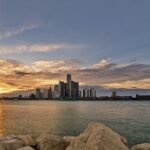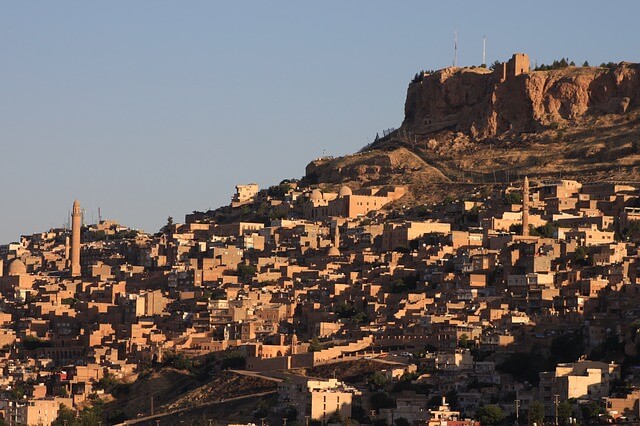Why You Should Learn Arabic? Why Not Something Else?
Arabic is the fourth-most-spoken language in the world, with about 400 million speakers. If numbers are all that matter, why learn Arabic when Chinese or Hindi has many millions more speakers?
Raw numbers are not the whole game. We associate Arabic with the Middle East and North Africa, but people and the languages they speak are not tied down to any geographic area. Over the centuries, millions of people from the Arab world have left their home countries to seek better opportunities and to flee conflict. These people, naturally, brought their culture and language with them, and it is these people who have made Arabic the world language it is today. This blog post will provide a brief glimpse into just a few places outside the Arab world where Arabic is frequently spoken, showing you that the language is all around us.
North America
Detroit
 The first people of Arab descent to immigrate to the United States were Lebanese and Syrian Christians fleeing turmoil in the Ottoman empire in the late 19th century. However, Arab immigration to Michigan began in earnest as the auto industry burgeoned. Excellent wages and a promise of a more peaceful life attracted people from all over the world. Later, in the seventies, the civil war in Lebanon resulted in another flock of immigrants, attracted to Detroit by the already large Arab community.
The first people of Arab descent to immigrate to the United States were Lebanese and Syrian Christians fleeing turmoil in the Ottoman empire in the late 19th century. However, Arab immigration to Michigan began in earnest as the auto industry burgeoned. Excellent wages and a promise of a more peaceful life attracted people from all over the world. Later, in the seventies, the civil war in Lebanon resulted in another flock of immigrants, attracted to Detroit by the already large Arab community.
Aside from Spanish, Arabic is the most spoken foreign language in Michigan. About 200,000 people of Arab descent live in the Detroit metropolitan area, and more than half continue to speak Arabic at home. Small businesses and stores with mixed English and Arabic signs are a common sight, and The Arab American, a bilingual newspaper, circulates to tens of thousands.
Montréal
 The largest French city outside of France is also home to a diverse collection of Arab-Canadian citizens and immigrants. Understandably, many come from the former French colonies of North Africa, but Montréal is also home to 40% of Canada’s Syrian-origin people and substantial numbers of Lebanese people.
The largest French city outside of France is also home to a diverse collection of Arab-Canadian citizens and immigrants. Understandably, many come from the former French colonies of North Africa, but Montréal is also home to 40% of Canada’s Syrian-origin people and substantial numbers of Lebanese people.
A large portion of these people are recent immigrants, so the Arabic language is alive and well in Montréal. Grocery stores with Arabic text advertising their goods are a common sight in many of Montréal’s boroughs. And tune in to 1450 AM for Middle East Radio, the only Arabic radio station in all of Canada.
Asia
Mardin
 This ancient city in southeastern Turkey has been a hub of cultural exchange for millennia. A look at its architecture shows influence from numerous peoples: Assyrian, Byzantine, Armenian, Syriac, Kurdish, and Arab, to name just a few. Mardin is so richly adorned with historical architecture that the Turkish government promotes it as an open-air museum. Many beautiful and ancient churches and mosques, as well as the enchanting landscape, make Mardin a destination for adventurous tourists.
This ancient city in southeastern Turkey has been a hub of cultural exchange for millennia. A look at its architecture shows influence from numerous peoples: Assyrian, Byzantine, Armenian, Syriac, Kurdish, and Arab, to name just a few. Mardin is so richly adorned with historical architecture that the Turkish government promotes it as an open-air museum. Many beautiful and ancient churches and mosques, as well as the enchanting landscape, make Mardin a destination for adventurous tourists.
Despite being a part of Turkey, Turkish is only the third-most spoken language in Mardin. Kurdish is the commonest language, with Arabic not far behind. Most of the Arabs of Mardin are from a group known as Mhallami, who live in southeastern Turkey and the coast of Lebanon. Visitors to Mardin might initially struggle to make sense of the dialect of Arabic Mhallami use, as they have borrowed much from their Turkish and Kurdish neighbors, but it is not fundamentally different from Levantine Arabic, making conversation possible.
Mindanao
Arab people have visited and traded with the people of the Philippines for thousands of years. But the Arabic language did not make a foothold until the fourteenth century, when Muslim missionaries migrated throughout southeast Asia, spreading their faith and the Arabic language with it. Those traders and missionaries were particularly successful on Mindanao, the large, southern island of the Philippines.
About 2% of the population of the Philippines—2.2 million people—claim Arab ancestry, and between 5 and 10 million follow Islam. But you would be mistaken if you thought that Arabic was used only liturgically. The constitution of the Philippines includes a section encouraging the voluntary learning and use of Arabic. (This is no small honor, as there are more than a hundred languages used in the Philippines.) To this end, many schools in Mindanao include MSA in their curricula, and many learn the Arabic alphabet at least, to better understand many shops and signs which use that alphabet.
The language is especially useful for the many Filipino citizens—2.5 million—who work in the Middle East, remitting their wages to families back home. “Why learn Arabic?” has a compelling economic answer for these people; naturally, they can secure better jobs and live more comfortably if they know some Arabic before moving to the Middle East. Going in the other direction, many Middle Eastern entrepreneurs have sought business opportunities in the Philippines, continuing a history of trade that has existed for centuries.
Europe
Paris
 Aside from French people, Arabs are the largest ethnic group in Paris, with people from Algeria, Tunisia, and the other former French colonies of North Africa making up the bulk of immigrants, though there is a significant Lebanese diaspora as well. (Incidentally, there are no official population numbers for ethnicities in France, as the government does not collect ethnic statistics.)
Aside from French people, Arabs are the largest ethnic group in Paris, with people from Algeria, Tunisia, and the other former French colonies of North Africa making up the bulk of immigrants, though there is a significant Lebanese diaspora as well. (Incidentally, there are no official population numbers for ethnicities in France, as the government does not collect ethnic statistics.)
Most Arab immigration to France happened quite recently, starting in the 1960s. Due to the relative youthfulness of the Arab-French population, the Arabic language is quite strong in Paris. Travel agencies use Arabic script in metro advertisements; exhibitions of Arabic music and art are frequent; some schools teach elective Arabic; and the state-owned television network, France 24, has an Arabic channel.
Stockholm
 For most of history, Finnish was Sweden’s most common foreign language. However, the number of Arabic speakers in Sweden has doubled in the last decade, shooting that language into the #2 spot.
For most of history, Finnish was Sweden’s most common foreign language. However, the number of Arabic speakers in Sweden has doubled in the last decade, shooting that language into the #2 spot.
Arabic is now a part of Arabic daily life in Stockholm. Radio Sweden has maintained an Arabic channel since 2013, and 2017 saw the first Arabic book fair. Shortly before the COVID-19 shutdown, crowds flocked to Midnight Sun, a stage play performed in Arabic with Swedish subtitles. People can book digital medical checkups with Arabic-speaking doctors.
As in France, a precise number of Arabic speakers is impossible to establish in Sweden, but informal estimates suggest there are as many as 200,000. What is certain is that the Arabic-speaking community is lively in Stockholm, making a strong impact on entertainment and services.
Why Learn Arabic? Look around You!
This list is, of course, incomplete. But almost every city in the world has some Arabic-speaking citizens, truly making it a world language. Maybe you want to make a connection with a new neighbor, or better understand a museum or cultural exhibit, or just understand what mysterious spices they put in little bottles at the charming, ethnic grocery store down the street. Let us help you learn Arabic online. You won’t have to go far to practice.

